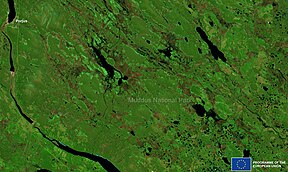| Muddus National Park | |
|---|---|
| |
| IUCN category II (national park) | |
 A satellite image of the park. A satellite image of the park. | |
| Location | Norrbotten County, Sweden |
| Nearest city | Gällivare and Jokkmokk |
| Coordinates | 66°54′N 20°10′E / 66.900°N 20.167°E / 66.900; 20.167 |
| Area | 493.4 km (190.5 sq mi) |
| Established | 1942, extended 1948 |
| Governing body | Naturvårdsverket |
Muddus (Swedish: [ˈmɵ̌dːɵs]; Lule Sami: Muttos) is a national park in northern Sweden. It is situated in the province Lapland, with its largest part in the Gällivare Municipality. Furthermore, it belongs to the largely untouched UNESCO World Heritage classified Laponian area.
Natural scenes include the old-growth forest with large trees, large boggy grounds, and deep ravines in between the rocks. Sweden's oldest known pine tree is also located here. It has been estimated to be at least 710 years old, as it was found to have withstood a forest fire in 1413.
Wildfires
Forest fires in Muddus National Park have left traces on sample plots. There are fire scars on living or dead trees or charcoal fragments in the humus layer. The park was investigated on 75 separate sample plots. Some of the major fire years in the Muddus area coincide with forest fires in other parts of northern Sweden, in the taiga of western Russia, and in central Siberia. There is constant regeneration happening in the wildlife in the National Park. Forest fires were shown to have occurred in the five different types of forest. The fires that were most frequently occurring of fires in the pine forests occurred with within the span of 81–90 years, while the mean frequency was 110 years. The interval of time elapsed since the last forest fire occurred in the pine forests was 144 years. Some of the major fire years in the Muddus area coincide with forest fires in other parts of northern Sweden, in the taiga of western Russia, and in central Siberia.
Mires
In 1940 a range of mires were found in the Muddus National Park. The park also went under investigation for its mires and wetlands. The mires consisted from ombrotrophic bogs to rich fens. They are found to be very rich in bryophytes. There are 66 species and you can find them in dry habitats as well.
Geography
It is known for its waterfalls, deep ravines, low mountain and forest where the trees have seen many generations of people pass by.
Wildlife
Birds
Due to a large-scale forestry landscape structure; the structure and composition of boreal bird communities are in North Sweden. Birds control the effects of patch size, forest age and tree species compositions. The most common birds that live in the park are Capercaillie. These birds are black grouse and hazel hen. They are constantly being reproduced in the forest year-round. The second most common bird that is found here is the Siberian jay and Siberian tit. These birds are intensely present mostly during the summer time. Other animals that reside in the park are whooper swans, bean geese and black-throated loons appear on the lakes. Located at the marshes of the park, cranes, sandpipers and snipes are present
Deers
Reindeer are in the Muddus National park are present in the area year-around. Although rare, there are also brown bears, lynx and wolverines in the park. It is common, to encounter reindeer, elk or some of the forests’ and marshes’ many birds.
Flora
The Muddus National Park trees show how large non-systematic variations are there. This is due to climatic changes because of industrialization in Sweden through the years.
There are an abundance of spiders that have been found in the Muddus National Park. In particular, There has been four species of different genital characters of spiders have been found. This is due to the abundance of spruce, pine forest, and shallow lakes in the northern taiga zone. There was 157 spiders collected from the southern park of the park.

havet
See also
References
- ^ "Muddus National Park". Naturvårdsverket. Retrieved 2009-02-26.
- ^ "Canadian Science Publishing". doi:10.1139/b84-127.
{{cite journal}}: Cite journal requires|journal=(help) - ^ Engelmark, Ola; Hofgaard, Annika; Arnborg, Tore (August 1998). "Successional Trends 219 Years after Fire in an Old Pinus sylvestris Stand in Northern Sweden". Journal of Vegetation Science. 9 (4): 583. doi:10.2307/3237274. ISSN 1100-9233. JSTOR 3237274.
- ^ ENGELMARK, OLA (1987). "Fire history correlations to forest type and topography in northern Sweden". Annales Botanici Fennici. 24 (4): 317–324. JSTOR 23725752.
- ^ Sjörs, Hugo; Een, Gillis (January 2000). "Wetland bryophytes in Muddus National Park, North Sweden". Journal of Bryology. 22 (3): 223–236. doi:10.1179/jbr.2000.22.3.223. ISSN 0373-6687. S2CID 84200845.
- ^ "Wildlife | National Park Fact | Muddus / Muttos national park | Choose National Park | Sweden's national parks". Sveriges nationalparker. Retrieved 2018-10-08.
- ^ "CAB Direct". www.cabdirect.org. Retrieved 2018-10-08.
External links
- Sweden's National Parks: Muddus/Muottos National Park from the Swedish Environmental Protection Agency